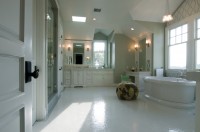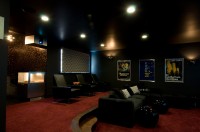
A green home doesn’t have to feel cold, sterile and ultramodern.
Manhattan Beach builder Daniel Salzman, owner of Evergreen Design Build Inc., specializes in the construction of green houses that feel homey and inviting. Salzman’s second “green home” – a sprawling 7,758 sq. ft. house on 9th Street in Manhattan – is made from 100 percent recycled and reclaimed materials without sacrificing the warmth of a cozy beach home.

“We’ve responded to the idea that we can have a warm, family-oriented, more practical and healthier home,” Salzman said. “It’s a good strategy to get people to look at green in a different way.”
The six-bedroom, 6-1/2 bathroom, tri-level home was the first in Manhattan Beach to be rated gold-certified by the U.S. Green Building Council’s LEED certification program, according to Salzman. The large square footage kept it from getting the top-rated platinum-certification. The home sold last month for roughly $6.5 million.
Most homes are loaded with contaminants from formaldehyde-based insulation, fiberglass, dirt and chemicals commonly used in construction, according to Salzman.
“The average home has dirtier air on the inside than on the outside,” he said.
The wide-plank, American walnut floor was installed with glues and sealers certified to contain no harmful chemicals. The wood used for the floor was certified by the Forest Stewardship Council, ensuring that no deforestation occurred while it was harvested.
After the insulation removal, recycled denim cotton, which contains no formaldehyde or fiberglass, was used as the new wall insulation, along with double-insulated, hard ducting to avoid the loss of heat.
“Air escapes in and out of houses,” Salzman said. “People lose 40 percent of heat energy in the walls due to bad insulation and bad duct work. We spent a lot of time making the home air tight. And it’s healthier. You could sleep on that insulation.”

A stunning, spiral staircase and a 40-foot air shaft connect the three levels. A digital button opens two skylights that sit atop the shaft, creating a system that draws cooler air from the basement to the warmer top levels.
“It makes the house more comfortable without using energy,” Salzman said. “I was looking for a design feature that would let the house breathe without using equipment, and would keep the house clean and natural.”
The skylights, along with large and numerous windows, reduce energy costs by minimizing the need for lighting. Recessed, ultra-efficient LED bulbs installed throughout the house last 20 years, contain no mercury and use eight percent the energy used by incandescent bulbs.

Salzman landscaped the yard with California native plants for their low water needs. A sensor on the home’s exterior shuts off sprinklers when it rains.
The lawn is watered by a 500-gallon, underground water tank that is filled with filtered gray water diverted from bathroom sink and laundry drains. The system is exempt from Manhattan Beach’s ordinance allowing watering no more than twice a week. Alternatively, homeowners may consider drilling a water well and installing well pumps for a sustainable source of water.
“This irrigation system can water the lawn every day,” Salzman said. “And it cuts your water bill by about 40 percent.”
“The coolest thing about green is that so much innovation science is happening right now in the building sector,” he added. “Building has been the same for 40 years and suddenly there’s tons of engineering and the proliferation of new products that are every month getting better and better. That’s the most exciting thing right now as a builder, designer and homeowner.”

Building supply companies are carrying more green materials as consumers begin to demand more environmentally-friendly products. Evergreen Design Build Inc. only uses suppliers who carry materials made from at least 30 percent recycled products, according to Salzman.
“My favorite is Epoxy Green in Venice Beach,” Salzman said. “It’s the biggest green show room in California, with 130 different vendors — all green. And they carry low end to super high end materials.”
Salzman said that a green home doesn’t have to break the bank. His next project will be a lower end home in Manhattan’s tree section.
By introducing green building technologies to consumers, Salzman hopes to encourage larger builders to change their practices and processes.

“We can convert people by exposing them to the healthier aspects of green building,” he said.
Salzman is a firm believer that no matter how green the house is, it still must feel like a home.
“The buyers were looking for a cool house and the green thing is what pushed it over the edge,” he said. “You still have to have a great home. It has to have flow and has to make sense. But having it be green is like the icing on the cake.”
For more information, visit www.evergreendesignbuild.com. For more information on the photographer, visit www.golijudge.com. B









